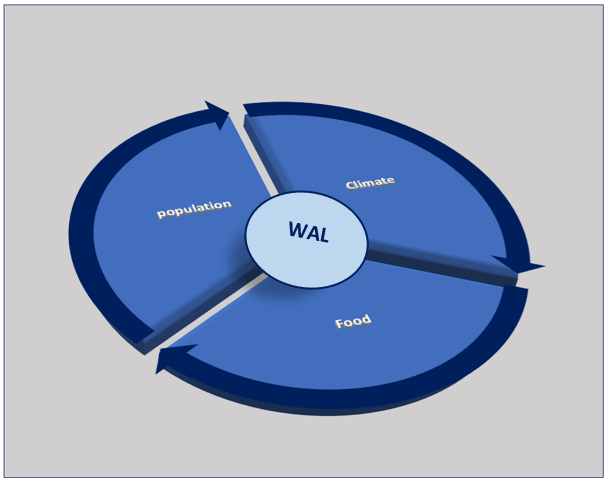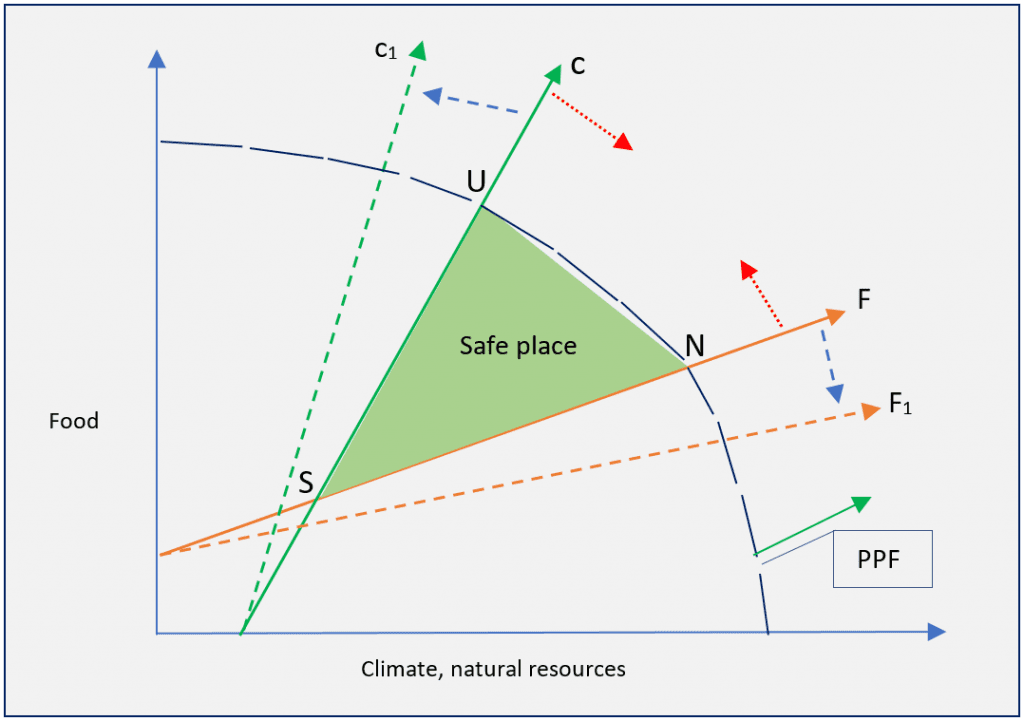Water, Air and Land (WAL) Nexus: A Safe Space for Preserving Climate and Achieving Food Security
By Jagadish Wagle of INCOMESCO
Water, Air and Land
According to the classical economist David Ricardo, the drivers of food production such as water, air and land (WAL) are free gifts from nature. No one should have to pay any price to have them supplied, because they are produced and delivered by nature with no cost. However, modern economists argue that this idea helps only rent seekers, and that such natural resources are not truly free. The supply of land in a country is, after all, completely inelastic.
Humans benefit hugely from the services delivered by nature. However, due to an increasing population and the unlimited greed of human activities, limited natural resources are inhumanly exploited and are stressed. To protect nature, the majority of scientists have warned that some planetary boundaries have already been crossed and that sudden collapse is very near. Hence, a huge global debate is going on regarding how to protect, preserve and utilise natural resources in a sustainable way.
These issues should be analysed, in consideration of the COVID-19 pandemic and the financial crisis of 2008, and it should be considered whether our past development has addressed real needs. Father of modern linguistics Noam Chomsky underlined the fact on our Corona virus response that “ventilator shortage exposes the cruelty of neoliberal capitalism”. This seems to imply that, somehow, both nature and humanity are being ignored in the global development discourse.
The development approach following the five stages of growth, propounded by WW Rostow, is a move from agriculture to mass consumption through industrialisation and urbanisation. The five stages of growth has put quantity, quality and capacity of the WAL (water, air and land) at risk due to rampant modification of resources. At their current stress levels, they are unable to produce the services properly.
The alarms that are being sounded on global warming, income inequality, and humanitarian crises are the result of materialistic greed. However, Brundtland Commission has ratified the development approach by underlining sustainable development. The Commission has given a huge importance to the environment. Sustainable development is understood as a combination of the three pillars of socio, economic and environmental development. So, limiting human strain on natural resources is the main area of concern to ensure the earth is able to fulfil increasing food demand by reducing stress on climate.
Considering potential risks, the Paris Agreement-2015 is the latest global initiative to keep the increase of the earth’s temperature (global warming) below 1.5c. This global commitment is not possible without a huge investment. Yet, who is going to invest, and under what modality, is still under consideration.
All nations are requested to show their commitment by promulgating law and policy that promote investments in preserving the climate. In the meantime, a major investment partner of the global economy, the US government, withdrew from the Paris Agreement in 2019. A denial in implementing the Paris Agreement, without offering an alternative solution, is an unconscious action against the seriousness of the threat of climate change. A huge number of scientist and climate activist are worried and have argued that the richest must invest more as they have a greater ability to exploit nature.
Population, climate and food (PCF) are deeply entangled. Over-exploitation of natural resources, increasing population, climate emergencies and food insecurity have posed a serious threat. Thus, a nexus of WAL should be considered while implementing polices of the PCF. This will lead to a wider safe space, which is an approach where an optimum level of productivity is possible from the least amount of resources.
This safe space offers a sustainable way of acquiring natural resources to fulfil increasing demand. Considering the PCF and the WAL in a policy together is a kind of trade-off, a synergistic analysis approach. This approach has been highly promoted in the Sustainable Development Goals (SDGs). Further, the Production Possibility Frontier (PPF) helps to understand the safe space approach. Before discussing the safe space further, it is better to underline something about an aspect of the PFC which affects the WAL.
Population
Increasing population is a biological phenomenon that cannot be stopped without proper policy implementation. According to TR Malthus, Population increases exponentially, by doubling in size (2 4 8 16…) every 25 years; whereas food production increases in linear (1 2 3 4…) terms. Further, Malthus strongly advises to adopt preventive measures and natural checks to control population.
According to him, contraception and self-control (avoiding reproductive activities) are a preventive measure. Natural checks include natural disasters, pandemics and famine. He even predicts that, if preventive measures are not effective, they could directly lead to worst case scenario natural checks. For a recent example see the severity of the impact of climate change and of COVID-19. Moreover, the destruction of the advanced Mayan civilisation is a good lesson on the effect of drought and famine. Hence, blindly increasing population is not only a challenge but also an exploitation of the resources.
Climate
Allowing nature to perform its activities without any obstacle is one type of sustainable approach. A sustainable eco-system is full of complementary benefits. For example, humans and trees benefit each other by supplying oxygen and carbon dioxide. Similarly, water and trees complement each other. However, the climate has been severely endangered due to an unlimited amount of human greed and inhumane activities. Promoting a nexus of WAL is a sustainable way of keeping eco-systems safe.

To preserve climate, man should be able to limit consumption of resources to fulfil no more than his essential need. Indeed, a human’s needs can be easily fulfilled, but it is quite impossible to fulfil greed. Hence, any development approach and outcome should consider whether nature (water, air and land) is being preserved. It is urgent to rationalise human behaviour by understanding the limited capacity of natural resources.
Food security
The ever-increasing size of our population has increased the quantity and quality of food but decreased availability of resources (WAL). What we need to do is create a vastly wider safe zone between our capacity for food production and the stress level that this production creates on the climate.
Agriculture systems are by far our main sources of food, and yet they are extremely climate sensitive. The increasing demand of our growing population has put immense pressure on the WAL. On the other hand, agriculture itself is a source (comprising about 21 percent) of Green House Gas (GHG) emissions, which affects the productivity of agriculture negatively, and so ultimately humanity and the climate too. It is a responsibility of the policy makers to take this risk into consideration and minimise it as much as possible.
A safe space
The Production Possibility Frontier (PPF) guides the policy makers to create a safe space between the quantity of food production and climate stress. The PPF helps to maximise the productivity from the options while also analysing the trade-off.

Source: Wagle, J., 2018. Establishment of Resilience in Rice System for Food Security in Nepal, University of Reading
In the figure above, the Production Possibility Frontier (PPF) curve shows an amount of food production under the available natural resources; the curve F shows food supply and C shows climate stress under given quantity of resources. The real amount of food supply can be increased by eliminating food waste, granting inclusive food access for all, and promoting veganism without exploiting more resources.
In this situation, the supply curve of food F goes down to F2. Similarly, the productivity of per unit resource can be increased by promoting investment, research and development, crop intensification and genetically modified crop systems. Hence, the curve C moves back to C1 to show less stress on climate. The area SUN is a safe space that needs to be wider.
The approach of “safe space” is a way of producing food with less climate stress, rationalising the use of the WAL. It guides people to rationalise their behaviour in view of a sustainable welfare approach. Hence, a country can produce the highest level of food with a minimum unit of resources by reducing climate shocks. This smart resilience agriculture system works through wider safe space from crop intensification, diversification, technological advancement, adaptive governance and so on. This gap should be addresses in due course to achieve a goal of maximising food production to feed an increasing population with nominal stress on water, air and land.